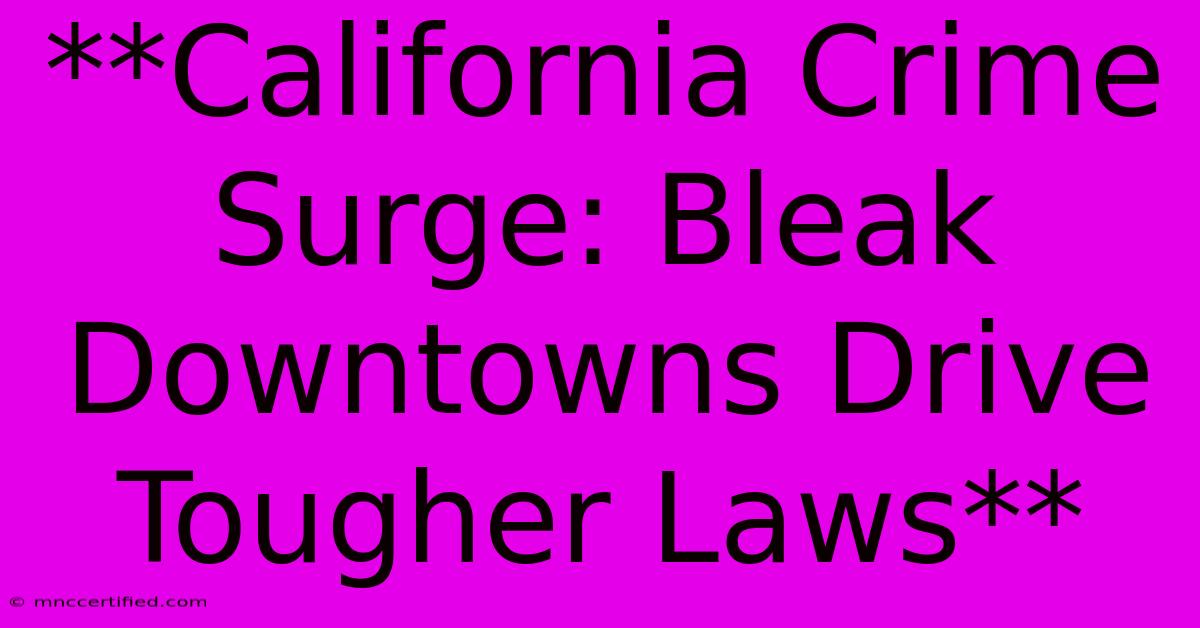**California Crime Surge: Bleak Downtowns Drive Tougher Laws**

Table of Contents
California Crime Surge: Bleak Downtowns Drive Tougher Laws
California's recent crime surge has become a major talking point, particularly in urban areas. The issue is so prominent that it has sparked a call for tougher laws and renewed focus on public safety. While some argue that the state's progressive policies are to blame, others highlight complex social and economic factors contributing to the rise in crime. This article explores the multifaceted issue of California's crime surge, delving into the factors driving it, the proposed solutions, and the ongoing debate surrounding them.
The Bleak Reality of California's Downtowns
From San Francisco to Los Angeles, California's once vibrant downtowns are struggling with a wave of crime, homelessness, and drug addiction. This bleak reality is fueled by various factors, including:
- Economic Inequality: The widening gap between the rich and poor has created a breeding ground for desperation and crime.
- Mental Health Crisis: A severe shortage of mental health resources, coupled with the stigma surrounding mental illness, leaves many vulnerable individuals without access to critical support.
- Drug Addiction: The opioid epidemic continues to grip the state, leading to widespread addiction and criminal activity related to drug trafficking and theft.
- Homelessness: The soaring cost of housing and lack of affordable options have pushed countless Californians onto the streets, creating a cycle of poverty and despair.
These factors are interconnected and contribute to the perception of a crime surge. However, it's essential to understand that the actual crime rate is not necessarily skyrocketing in all areas.
The Public's Demand for Action
The perceived rise in crime has fueled public anger and frustration, leading to calls for tougher laws and increased police presence. Many believe that the state's progressive policies on criminal justice have contributed to the problem, pushing for changes like:
- Increased Police Funding: Proponents of this approach argue that more police officers are needed to combat crime effectively.
- Tougher Sentencing: They also call for harsher penalties for certain crimes, especially repeat offenses.
- Reversing Bail Reform: Critics of bail reform argue that it allows dangerous individuals to remain on the streets, posing a threat to public safety.
The Counterarguments and the Path Forward
While the call for tougher laws resonates with many, others argue that this approach is misguided and potentially harmful. They point to the following:
- Focus on Root Causes: They believe that focusing on social and economic factors, such as poverty, homelessness, and mental health, is crucial to addressing the issue at its core.
- Investment in Social Programs: This includes expanding affordable housing, providing job training, and increasing access to mental health services.
- Rethinking Policing: Advocates argue that law enforcement practices should be reformed to focus on community policing and restorative justice.
It's clear that the solution to California's crime surge is multifaceted and complex. There's no easy fix, and a balanced approach that addresses both social and legal issues is crucial.
The Ongoing Debate and the Future of Public Safety
The debate surrounding California's crime surge will likely continue. This ongoing discussion is vital as it compels policymakers to find effective solutions that address the root causes of crime while ensuring public safety. The future of California's public safety hinges on finding a balance between tough law enforcement and social programs that target the root causes of crime.
Keywords: California crime, crime surge, downtown crime, public safety, homelessness, mental health, drug addiction, economic inequality, police funding, tougher sentencing, bail reform, social programs, restorative justice.

Thank you for visiting our website wich cover about **California Crime Surge: Bleak Downtowns Drive Tougher Laws**. We hope the information provided has been useful to you. Feel free to contact us if you have any questions or need further assistance. See you next time and dont miss to bookmark.
Featured Posts
-
How To Start A Real Estate Investment Fund
Nov 07, 2024
-
One Dead In Uk Motorway Hgv Crash
Nov 07, 2024
-
Bonding And Molecular Structure Worksheet
Nov 07, 2024
-
Fc Barcelona Wins Big Against Estrella Roja
Nov 07, 2024
-
Prop 36 Wins Californians Back Reform
Nov 07, 2024